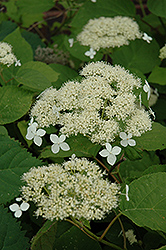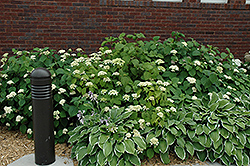Plant Library
White Dome Hydrangea
Hydrangea arborescens 'White Dome'
Height: 4 feet
Spread: 5 feet
Sunlight:
![]()
![]()
Hardiness Zone: 3b
Description:
An exciting new introduction to the world of hydrangeas, this coarse shrub produces numerous dome-shaped delicate lacecap-style flowers; best if treated like a perennial and pruned to a few inches from the ground in spring, as it blooms on new growth
Ornamental Features
White Dome Hydrangea features dainty white lacecap flowers at the ends of the branches from mid to late summer. The flowers are excellent for cutting. It has dark green deciduous foliage. The heart-shaped leaves do not develop any appreciable fall colour.
Landscape Attributes
White Dome Hydrangea is a multi-stemmed deciduous shrub with an upright spreading habit of growth. Its strikingly bold and coarse texture can be very effective in a balanced landscape composition.
This shrub will require occasional maintenance and upkeep, and is best pruned in late winter once the threat of extreme cold has passed. It has no significant negative characteristics.
White Dome Hydrangea is recommended for the following landscape applications;
- Mass Planting
- General Garden Use
- Naturalizing And Woodland Gardens
Planting & Growing
White Dome Hydrangea will grow to be about 4 feet tall at maturity, with a spread of 5 feet. It tends to be a little leggy, with a typical clearance of 1 foot from the ground. It grows at a fast rate, and under ideal conditions can be expected to live for approximately 20 years.
This shrub does best in full sun to partial shade. You may want to keep it away from hot, dry locations that receive direct afternoon sun or which get reflected sunlight, such as against the south side of a white wall. It prefers to grow in average to moist conditions, and shouldn't be allowed to dry out. It is not particular as to soil type or pH. It is highly tolerant of urban pollution and will even thrive in inner city environments. Consider applying a thick mulch around the root zone in winter to protect it in exposed locations or colder microclimates. This is a selection of a native North American species.



